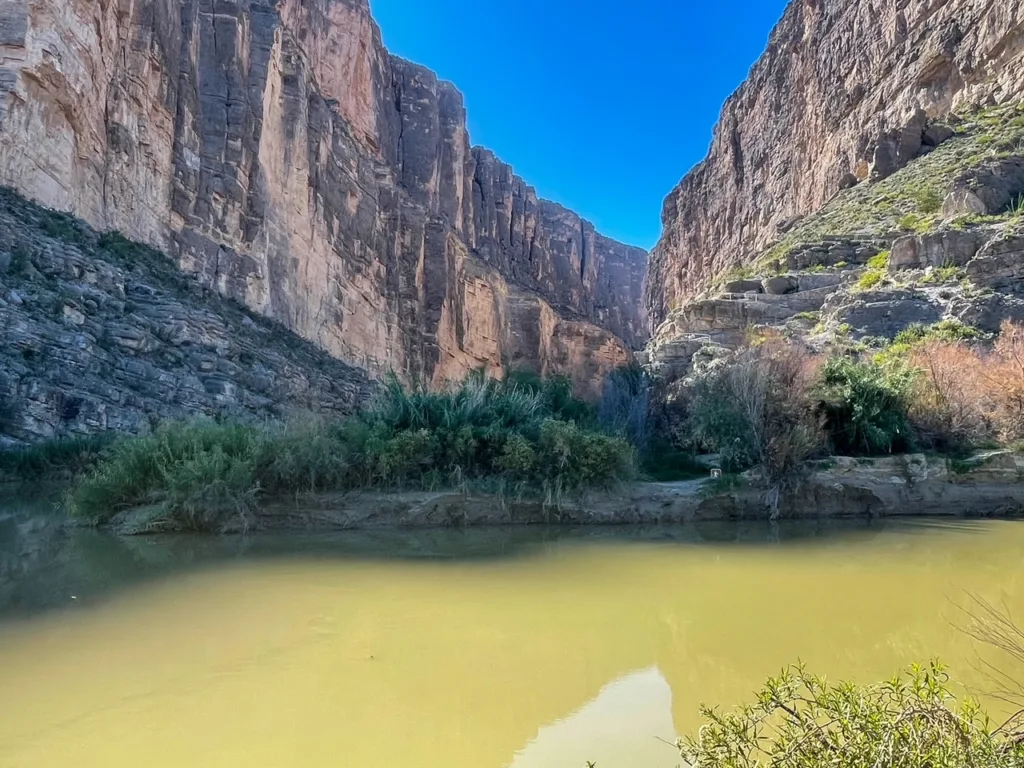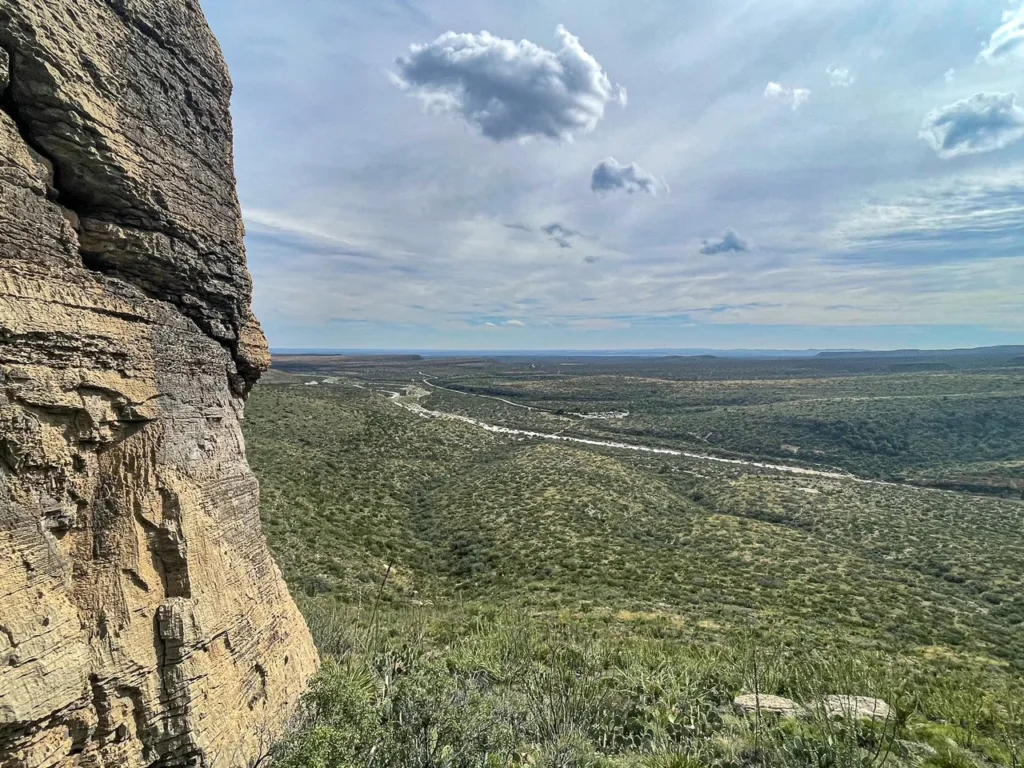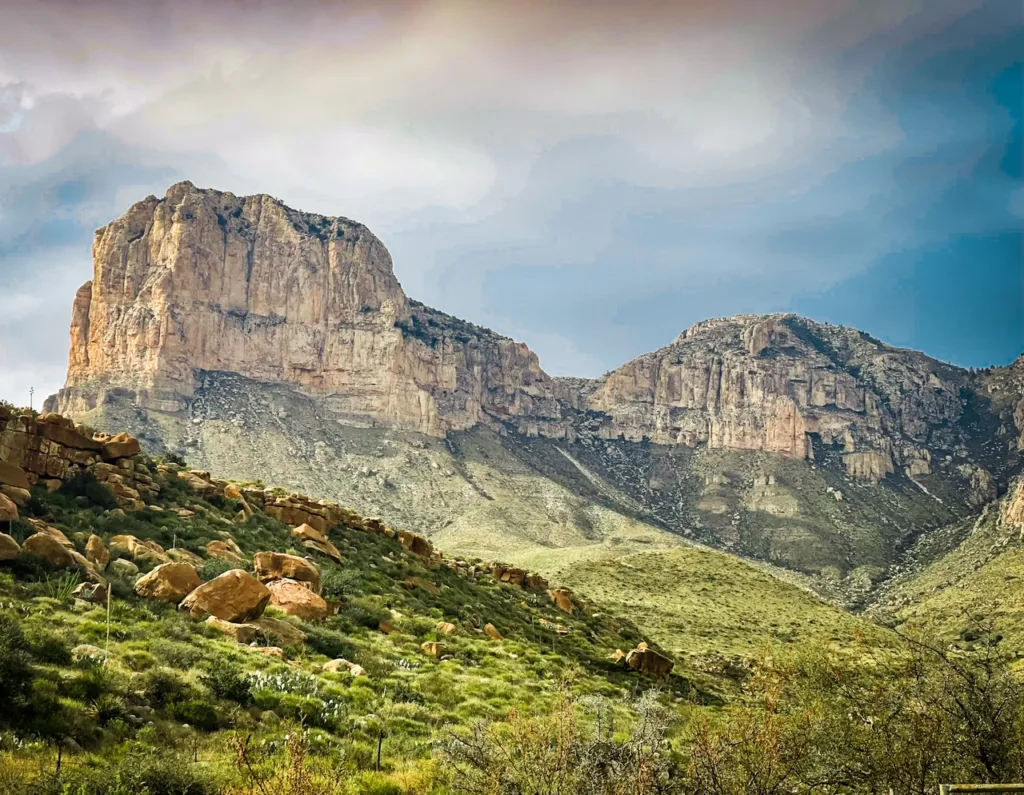The Lone Star State has some of the most incredible federally protected sites in the United States. There are 16 sites within Texas, including 2 National Parks, 2 National Monuments, a scenic river, national seashore, 2 national recreation areas, and several national historic sites. There are also 2 national historic trails that pass through Texas as well. The following are several locations you can visit throughout the state.
National Parks in Texas
The crown jewel of the National Park System, National Parks take an act of congress to create and have higher protections than some of the other protected spaces. Within Texas there are 2 National Parks, Big Bend and Guadalupe Mountains.

Big Bend National Park
Established in 1940, Big Bend National Park protects the rugged Chihuahuan desert along the Rio Grande on the border of Mexico. It is actually the largest protected area of the Chihuahuan desert and is named for the “Big Bend” in the Rio Grande along the river.
The park is known for its beautiful landscape, varied animal and plant life, beautiful canyons, mountains, hot springs, and more. The site is also a well known location for fossils as well as archaeological findings from prior cultures that lived through this land. Some of the best hikes in Big Bend include Santa Elena Canon, Lost Mine, window trail, and balanced rock.
Guadalupe Mountains National Park
Established in 1972, Guadalupe Mountains National Park preserves the mountains and areas of Guadalupe Mountains, Chihuahuan Desert, as well the highest peak in Texas. The park is named for the Guadalupe Mountains of which Guadalupe Peak is the highest. Other notable peaks include El Capitan, Shumard Peak, Bartlett Peak, and Hunter Peak. Guadalupe Mountains NP has some incredible hikes and places to explore including Devil’s Hall, McKittrick Canyon, Guadalupe Mountain Peak, Permian Reef, and Smith Spring.

National Monuments in Texas
National Monuments are similar to National Parks, but protect a greater diversity of places many of which are historical, cultural, or of scientific interest. Additionally, National Monuments can be created by the president while National Parks require congressional action. While most National Monuments are administered by the National Park Service, they can be administered by other agencies as well.
There are two National Monuments in Texas managed by the National Park Service. There is an additional one Military Working Dogs, that is not listed that is administered by the Department of Defense.
Alibates Flint Quarries National Monument
Millenia ago, local hunters came to the flint quarries of Alibates for tools and weapons, many of which were used to hunt Mammoths that roamed the area. Established in 1965, the National Monument protects this incredible land that has seen cultures from ancient to more recent use these lands and flint for important aspects of life.
In more recent years, the ancient Puebloan cultures that roamed this area prior to European Settlement used flints for tools and ceremonies. The colorful flint was highly prized and traded long distances. The monument also has ancient dwellings, however due to their sensitivity require special permission to visit.
Waco Mammoth National Monument
It seems almost unreal, but massive Columbian Mammoths, weighing upwards of 10 tons roamed the lands that are now West Texas. The Waco Mammoth National Monument protects one of the most important and impressive fossil finds of Mammoths in the world.
The impressive part is the mammoths on the site did not all die from the same event, but instead died from several separate events that occurred in this area. The first fossils here were discovered in 1978 and than additional excavating discovered the extent of the site. It was then years later in 2015 that this site was established as a National Monument. This shockingly small national monument has an immense amount of things to explore and certainly fascinating to experience.

Other National Park Units in Texas
The following are other National Park Units within Texas. These are National Memorials, Recreation Areas, Preserves, Historic Sites, Presidential Homes & Libraries, Seashore, a wild river, and more. There’s a lot of history in Texas and many of these sites delve into it.
Amistad National Recreation Area
Located around the Amistad Reservoir along the Rio Grande and Devil’s River, the Recreation Area provides visitors with great opportunity to enjoy the land and waters of the area. The reservoir was first formed in 1969 with the building of the Amistad Dam on the US-Mexico Border.
Big Thicket National Preserve
Established in 1974, Big Ticket National Preserve protects an incredible diverse ecosystem of hundreds of plant species. The heavily forested area in east Texas protects not amazing hardwoods and plants, but a high diversity of animal life as well. There’s over 50 mammal species in the area, including foxes, bobcat, coyotes, beavers, flying squirrels, deer, mink, and armadillos. Bears once roamed this area and have been making somewhat of a comeback as well. Other big mammals such as ocelots, wolves, and jaguars once roamed these lands but were driven out many years prior.
These days visitors come to explore the beautiful diverse landscape, one of the biggest swaths of hardwood forests in this area of the United States. Popular activities include, hiking, kayaking, canoeing, camping, mountain biking, and fishing. Certain animal such as rabbits, white-tailed deer, and invasive feral pigs can also be hunted in parts of the preserve.
Chamizal National Memorial
What is in a border? That is the situation that Chamizal found itself in, during a dispute between US and Mexico on where the border is located. The Rio Grand would until recently change its direction with the years and thus the border with it. For years, there were also disputes and concerns with the border, and settling on areas that likely did not belong to one country or another.
The Chamizal National Memorial commemorates the agreement between the US and Mexico on where the border was, and construction of canals to settle the river as well. The Chamizal convention of 1963 required both the US and Mexico to exchange land and in many ways also move and resettle people as well. This surprisingly peaceful movement represented a look at cooperation between these two countries.
Established in 1974, the Chamizal National Memorial contains information, artifacts, murals, and other information about this historic agreement.
Fort Davis National Historic Site
Fort Davis saw life from the mid to late 19th century as a Indian Wars frontier outpost. These days it’s the best surviving example from that era, and showcases the history of the region, emigration of people, supply lines, and history of interactions and conflict with the native population in the area.
In the later part of the 19th century, the fort saw occupation by Confederate troops during the civil war and then later was re-occupied by federal troops where it became a major installation with more than 100 structures.
The fort saw action in fighting with local tribes in the area through the late 19th century until it was finally abandoned in 1891. Years later, the National Historic Site was established in 1961 to protect the fort and showcase it’s history and artifacts.
Lake Meredith National Recreation Area
Located North of Amarillo, the Lake Meredith National Recreation Area is an oasis in an otherwise dry Texas panhandle. The main area to visit it the massive Lake Meredith, created by the damming of the Canadian River.
The area is a popular recreation area, with annual visitors enjoying hiking, boating, camping, horseback riding, fishing, mountain biking. There’s also opportunity for off-road driving in the recreation area, with several areas designated for ORV use. Permits however are required for several activities including Off-roading and boating.
Popular hikes include the Harbor Bay, Mullinaw, Fritch Fortress, and South Turkey Creek trails. There are ranger led hikes and programs that occur seasonally in the park.

Lyndon B Johnson National Historic Park
Established in 1969, the Lyndon B John NHS preserves the legacy of the 36th American President. The National Historic Park encompasses the houses and ranch of the president and also includes the presidential plane and library.
The park itself is in multiple sections, with two areas for the National Historic Park, the “Texas White house” ranch and library, and the section in Johnson city with the boyhood home. Additionally there is a Lyndon Johnson State Park that abuts the ranch area.
Touring the ranch requires visitors to first drive through the ranch land and see the still working ranch before ending at the visitor center, plane, and other buildings. Johnson was known to often conduct business and welcome folks to the ranch during his presidency. Be sure to check out the plane often called Airforce 1-half, due to him being sworn in on the plane due to John F. Kennedy’s assassination.
Palo Alto Battlefield National Historic Park
Established in 1915, the Palo Alto Battlefield NHP preserves the battlefield from the 1846 fight between Mexican and US troops. The battle of Palo Alto turned out to be the first major battle of what would become known as the Mexican-American war. This war with the eventual treaty of Guadalupe-Hidalgo would completely change the landscape of North America and the borders of the two countries. It’s shocking to think the former Mexico border was along the Arkansas river with places in Colorado at Bent’s Old Fort.
This battle ended as a decisive US victory, there were many more battles to come over the following two years. At the National Historic Park, visitors can learn about the history of the war, the lead-up to the fighting, tour the battlefield grounds, and watch a movie at the visitor center about the history.
Padre Island National Seashore
Established in 1962, the Padre Island National Seashore protects 66 miles of Padre Island’s Gulf of Mexico coastline. Thanks to this protection, the area has been allowed to remain wild and is one of the few intact prairie coastal regions in the United States.
Padre Island is one of the largest US islands and extends 113 miles along the Texas coastline, with mostly southern areas of the Island Populated. Thanks to the protections, the area of the seashore has been allowed to stay natural thus protecting important breeding grounds and vegetation of the area.
Visitors to the island can explore beautiful coastline and beaches, kayak along the waters, camp, stargaze, and view many different local and migratory bird species. There’s even opportunity to watch sea turtles laying eggs and hatchlings going to the sea.
Rio Grande Wild & Scenic River
There are few areas of the Rio quite like the area protected by this National Park unit’s boundary. The Wild and Scenic River contains 196 miles of non-dammed area of the Texas Rio Grande allowing visitors to explore and enjoy this part of the Rio Grande.
The protected wild river runs through several different areas of the land including along the border of Big Bend National Park. Boating is the main attraction to do in the park, with several amazing canyons to float through including Boquillas Canyon, Mariscal Canyon, Lower Canyons, and Hot Springs Canyon.
San Antonio Missions National Historical Park
Established in 1983, the San Antonio Missions are both a National Park and a UNESCO World Heritage Site. Actually, the only World Heritage Site in Texas. The park protects 4 (of 5) historic Spanish missions within Texas that were founded for the spread of Christianity in the region.
The following missions, Concepción, San José, San Juan, Espada make up the historic site. Each of these missions are in separate locations but all within 2-3 miles of each other. The 5th and most famous mission, the Alamo, is part of a Texas historic Park and not this particular National Historical Park.
Visitors can explore the various missions, with their historic stone buildings, and learn about the history of Texas, Spanish Conquest, and the region through their visits. There’s even a hike and bike path that you can follow that connects all the missions. Just note that the path is not a loop, so you’ll have to plan your visits accordingly.
National Trails
National Trails are historic, scientific, and nature trails that traverse parts of the United States. These trails often cross through multiple states with some famous ones going over 1,000 miles. Most National Trails are not fully administered by the National Park Service and often have multiple agencies and private organizations managing all or part of the trail. There’s often also other National Park and historic sites that are crossed by the trails.
El Camino Real De Tierra Adentro National Historic Trail
During the Spanish Colonial era, New Mexico was connected to Mexico city via a route through the center of the current state. Important cities in New Mexico such as Santa Fe were important locations for the travel of ideas, supplies, and people between Mexico City and northern parts of the Spanish colonies. These Royal Roads as they were called ran out from the city to various lands (such as the one below for East Texas). This one called “Tierra Adentro” or Inner Land gave name to it’s location heading north into the land.
This road saw prominence from the 17th century and was an important thoroughfare for over 200 years following it. Following Spanish Rule, American goods and travelers along the Santa Fe Road and other routes became prominent for trade and people from the US. And more so, once the US took over New Mexico territory with the Treaty of Guadalupe Hidalgo, most of the trade with Mexico City and areas south declined significantly. The final curtain for the trail came about when the Railroad finally reached Santa Fe and El Paso, thus ending the value of the route for trade.
The trail still is an incredible piece of history with lots of sites along the way. And the exchange of goods, ideas, and people significantly changed the landscape of this land.
The present day Historic Trail runs from Espanola New Mexico to El Paso Texas. You likely can visit areas in Mexico however, not all are maintained as well as the US side. The majority of the US sites are in New Mexico, but Texas sites include, El Paso, Ysleta Mission Church, Casa Ortiz, and La Purisima Socorro Mission. [ TX NM ]
El Camino Real De Los Tejas National Historic Trail
During the Spanish era in present day Texas and nearby states, the Spanish had created a series of “Royal Roads” to tie various parts of the colonies to their capital in present day Mexico City. The Tejas were known as a particular band of Caddo Indians that were friendly to the Spanish in the area. The name Texas was derived from Caddo word Taysha, meaning friends. This particular historic trail began in the early 18th century, it became overtime an important road through the region of east Texas.
This historic trail was seminal in the history of the region, relationships with Native Populations and development of the land. Even after Mexican independence, the road continued to be important, with settlers and ranchers moving into the area and utilizing this route. This 2,500 mile route ran originally from Mexico City to the the border of the Louisiana which was French. These days the Route runs from Natchitoches, Louisiana to Laredo Texas.
The majority of the sites in Texas with notable places including Monument Hill, San Antonio Missions, McKinney Falls State Park, Fort Boggy, and more. [ TX LA ]

Frequently Asked Questions
The following are questions we frequently receive or find people come looking for in relation to information about Texas National Parks
How Many National Parks are in Texas?
There are Two National Parks within Texas (Big Bend and Guadalupe Mountains). However, there are 12 additional units managed by the National Park Service. Additionally, there are 2 National Historic Trails that have administration by NPS and other organizations (some trails cross other national park sites above).
What is the Largest National Park in Texas?
Big Bend with 801,163 acres (1,251.8 sq mi; 3,242.2 sq. km) is the largest National Park in Texas.
What is the smallest National Park in Texas?
The smallest national park unit in Texas is the Waco Mammoth National Monument at 5 acres. Guadalupe Mountains, is smallest in Texas with the National Park title at 86,367 acres (134.9 sq. mi. ; 349.5 sq. km.)
What is the Oldest National Park in Texas?
Established on June 12, 1944, Big Bend is the Oldest National Park in Texas.
Check out Nearby States National Park Sites
Louisiana | Oklahoma | New Mexico | Arkansas